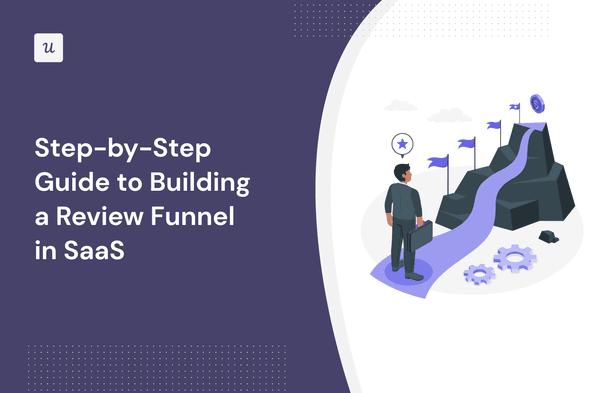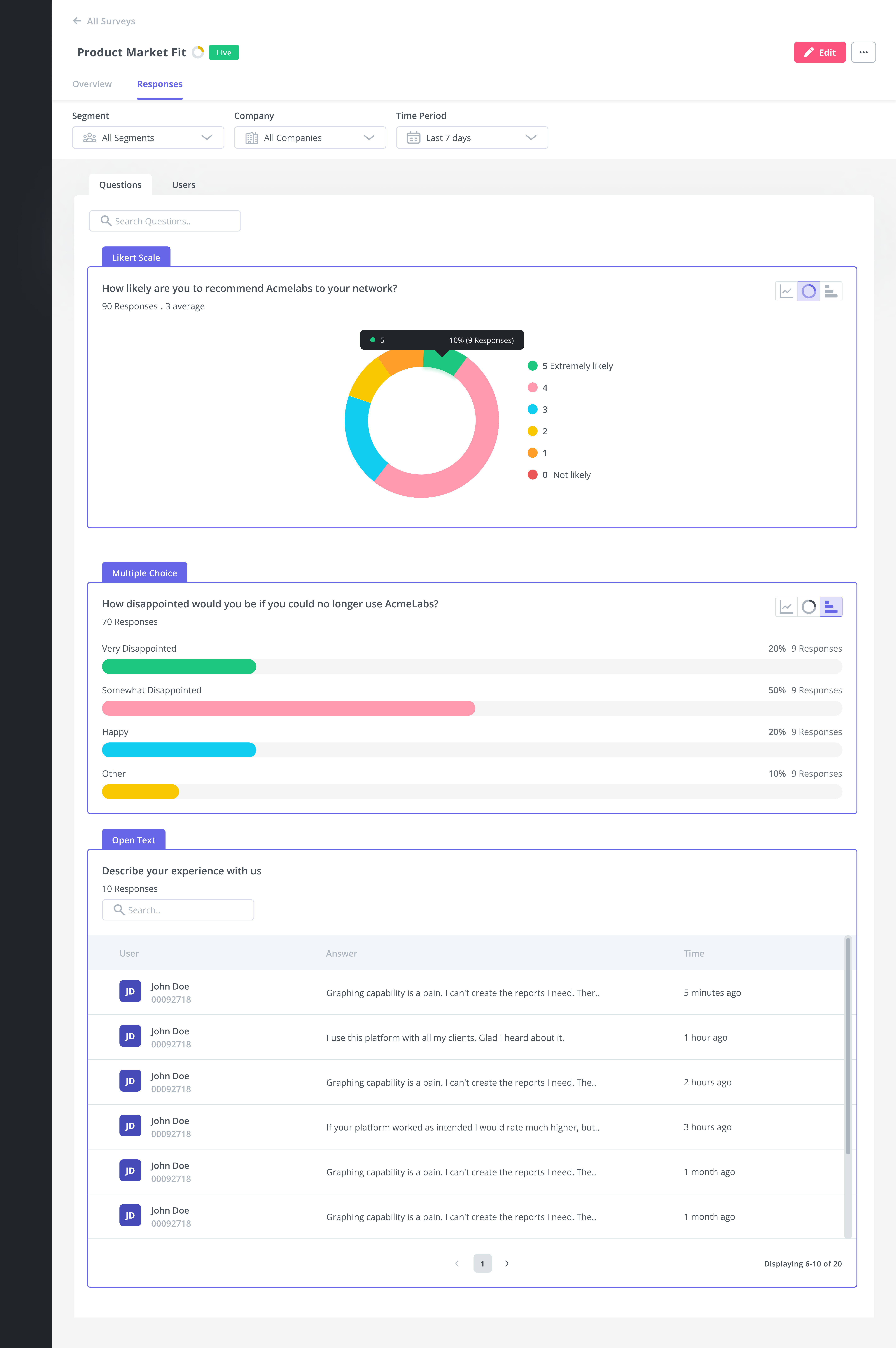
A review funnel is essential for every business, including your SaaS company. Customers trust real customer reviews just as much as recommendations from friends and family.
Building an effective review funnel that converts is pretty straightforward, but brands can get lost on its value.
This article discusses how you can build the perfect review funnel that influences product growth and attracts a consistent stream of positive online reviews on your website or third-party platforms.
Try Userpilot Now
See Why 1,000+ Teams Choose Userpilot

Summary of a review funnel
- A review funnel is a system that helps businesses manage customer feedback and increase chances of receiving positive reviews.
- Three benefits of designing a review funnel are building a better product roadmap, minimizing negative reviews, and driving customer loyalty.
- Collecting customer reviews from multiple channels is the first step to creating a review funnel. It can help you get customer insights to improve their experience.
- Use automated follow-up emails and messages to reassure customers that you take their feedback seriously.
- In case of negative reviews, invite the customer to a one-on-one interview to learn more about their problems and try to fix them.
- In case of positive feedback, thank customers and send them review requests to drive word-of-mouth referrals.
- Analyze the collected reviews to find improvement opportunities.
- Treat every feedback as important and create a plan to address customer suggestions and criticisms.
- Use a feedback tool to automate the review process across the sales funnel and address user complaints as quickly as possible.
- Use brand monitoring tools to track what your customers say about your products across multiple channels.
- Want to get started with feedback collection? Look no further! Book a demo with Userpilot, and we’ll show you how.
What is a review funnel?
A review funnel is an automated system used to gather and manage feedback. The process also includes generating positive reviews and driving customer loyalty.
What are the benefits of designing review funnels?
Online reviews strongly influence purchasing decisions, but they are more than just a reputation signal for your brand.
Use a review funnel to attract positive reviews, create more awareness for your brand, and drive customer loyalty.
Review funnels can also act as social proof to enhance the appeal of your business. Let’s now consider three key benefits:
Handle negative feedback and prevent it from becoming a negative review
It is nearly impossible to avoid negative reviews as a brand as a brand that lets users rate your product. You may receive a negative review for anything from a small human error to unmet expectations.
Although negative feedback can help your business grow, it can also hurt your online reputation. With a review funnel, though, you can manage negative sentiments before they go public.
For instance, if a customer gives your business one star out of five, you can use a review funnel to first hear their opinion privately. This way, you can respond to unhappy customers on a personal level, show them you care, and solve their problems.
Build a better product roadmap
You can only create a product that works if you pay attention to all reviews – positive and negative.
Review funnels give you a chance to extract valuable insights from your customers – to get their truest thoughts about your product and service. This can help you identify areas that require improvement so your products and services stay relevant.
Nurture customer relationships and drive loyalty
By learning about customer frustrations and improving your product based on their feedback, you show customers that their opinions matter. The insights from their feedback can help you establish long-term relationships with your customers, driving loyalty.
How to create a review funnel in 4 steps
Note that the exact system your review funnel follows will vary from one business to the next. Still, the process of creating it remains the same.

Let’s now explore four steps to creating your first review funnel:
Step 1: Gather customer feedback via multiple channels
The best way to know whether your product is providing value to your customers is to ask them. However, there are different ways to collect customer reviews to aid business growth.
Indeed, there are three key channels for collecting different kinds of feedback. They include:
In-app customer experience surveys
This system integrates micro surveys throughout the user journey to get insights into the customer experience in real time as they interact with your product.

There are three main types of customer experience surveys, including:
- Customer Satisfaction Score Survey: A customer satisfaction survey measures how happy customers are with a product, service, or interaction. The standard CSAT question is “How satisfied are you with your experience today?” on a 1-to-5 or 1-to-7 Likert scale.
- Customer Effort Score Survey: The Customer Effort Score is a metric that measures the perceived effort customers exert to interact with your business. You can use a 1 to 5 or 1 to 10 scale with questions like “How easy was it for you to get your problem solved today?” or “How easy was it for you to sign up for our trial?” to get insights into your CES score.
- Net Promoter Score Survey: The Net Promoter Score survey is a measure of customer loyalty to your company. To gather data for this survey, you’ll need to ask two questions: “How likely will you recommend our company to your friend?” and “What was the reason for your score?”.
Ratings on review sites
Reviews on third-party platforms like G2, Capterra, and Trustpilot are very valuable since they are unsolicited.
Review sites like these showcase real-life experiences that can help businesses make informed decisions to improve the quality of a product but also attract potential customers.

Customer support tickets and call logs
Although it isn’t a direct source of customer reviews, customer support tickets and call logs are a good source of customer feedback data. Product managers can review this data to identify the type of inquiries, issues, and call patterns they receive from customers.
For instance, call logging provides advanced reporting, analytics, and tracking to help businesses improve their call centers. This information can help businesses direct calls and customer support issues to the right agent or department to manage the issue.
The data collected here can also help product managers identify bugs or features in need of improvement.
Step 2: Acknowledge customer reviews with automated follow-up messages
The idea behind creating a review funnel is to make it an effective marketing system for your brand. To achieve this goal, you must engage with your customers.
So, when customers leave reviews, send automated follow-up messages to let them know you have received their feedback and are taking it seriously. Note, though, that your response will differ depending on whether the review is positive or negative.
How to respond to negative reviews from unhappy customers
If a customer leaves a negative review, address the customer by their name, thank them for their feedback, and show empathy for their frustration.
You should also accept responsibility and then send an email expressing your willingness to get more details about their issue and help them work through it.

How to respond to positive reviews from happy customers
When you receive positive feedback, take it as an opportunity to further strengthen the relationship and drive word-of-mouth referrals. To do that, send a thank you message with a modal and invite customers to leave a testimonial on a review site.
You can also encourage customers by offering a small gift as a reward.

Step 3: Analyze the collected reviews for actionable insights
Collecting customer reviews will add no value to your review funnel and brand without analysis. Building an effective review funnel means treating customer reviews like a goldmine. To do that, you must take the insights from reviews seriously.
One way to analyze the survey results is by visualizing them on a dashboard. This will help you easily spot trends and make decisions that can enhance your online reputation.

Step 4: Prioritize feedback and act on it
After gathering customer feedback from various channels, treat every feedback as important and identify any recurring suggestions or complaints.
As a general rule, focus on fixing critical issues first. Prioritizing items that require immediate attention will have the greatest impact. Create an action plan for implementing changes with a clear objective and timeline.

Finally, inform your customers about the adjustments you have made based on their feedback. This is an effective way to show customers you are responsive to their needs.
Tips to optimize the review process
Customer reviews are a critical marketing asset for any business. Optimizing the review generation process will boost efficiency, increase customer loyalty, and enhance satisfaction.
Here are three ways you can optimize the review process to create an effective review funnel:
Collect customer feedback from different segments to get better insights
You can use the different types of customer experience surveys like NPS, CSAT, and CES to collect online reviews from different user segments of your business.
While reviews are important, the “type” of review is just as valuable to your business. Sending relevant surveys to each user segment provides better accuracy as it makes your customers feel heard, important, and involved.

Automate the review collection process
Automate the review collection process with a feedback tool that lets you trigger in-app surveys based on custom events. You can easily spot and fix user complaints and guarantee a positive experience for your customers.
Use webhooks to send email surveys to save valuable time and build the trust and credibility of your business.

Keep track of online reviews with brand monitoring tools
Finally, ensure you use brand monitoring tools to keep track of what people say about your products across various social media channels. This will help you better understand how your brand is perceived, giving you a chance to engage with customers.
If you show customers how valuable their reviews are for your business, they will likely become lifelong customers and your biggest fans. You will also be able to encourage fence-sitters among your target audience to take action.

As insights from customer feedback help you make improvements for your business, you will increasingly influence the purchase decisions of your customers.
Conclusion
A well-crafted review funnel is a marketing asset. Customer feedback and reviews provide valuable insights and social proof that encourage potential customers to make a buying decision. Ultimately, you will be better able to guarantee excellent customer service, improve customer loyalty, and drive revenue.
Want to get started with creating a review funnel and building customer loyalty? Book a Userpilot demo to improve your marketing efforts and enhance your brand reputation.







